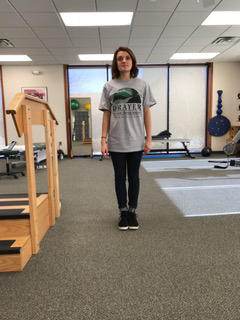6 Exercises to Improve Balance & Stability
Feb 23Poor balance can have a significantly negative effect on an individual’s quality of life — even limiting independence — whether it is the result of aging, surgery or neurological complications.
Balance is the ability to maintain your center of gravity within your base of support or, in simple terms, the ability to stand up and not fall over.
Dizziness often is used interchangeably with balance, but they are not the same. Dizziness is a sense of spinning or an internal sense of disequilibrium, both of which can cause balance deficits. However, poor balance does not necessitate dizziness.
Balance also can be differentiated as static balance (standing still, standing on one leg, etc.) and dynamic stability, or the ability to maintain balance during movement. For someone struggling with balance, static balance and dynamic stability often need to be addressed.
We get our sense of balance from three main body systems that work together. If one of the systems is not working well, the other two can compensate. However, if two of them are deficient, problems will arise.
- Visual: Our brain interprets visual input and develops balance reactions to our environment. As we age, we become more dependent on vision for balance.
- Vestibular: Sensory organs in our inner ear, the vestibular nerve, and certain areas of the brain and brain stem detect movement of our body. They relay information regarding where we are moving in our environment.
- Proprioception: This is the information coming from our joints and muscles that tells us where our body is in relation to itself. For instance, you can close your eyes and still touch your nose with your finger because your body knows where your finger and nose are.
Improvement with exercise
Balance and stability can be improved with exercise. A trained physical therapist can help determine the most appropriate program for your needs; however, there are some basic exercises that can benefit everyone.
When performing these exercises, it is important to follow safety precautions. Make sure you are next to something sturdy, such as a heavy chair or a counter top, that you can grab if you lose your balance. Also, it is always a good idea to have another person around to help you regain your balance before anything bad happens.
It is essential that you address all three systems that contribute to your balance. The following is a good plan and progression for improving your balance.
- 1. Work on your base of support
- a. Standing still, feet together
- Start by standing on a solid surface with your feet together and your eyes open
- Progress to standing on a soft surface such as a piece of foam or a pillow
- Now stand back on solid ground with your eyes closed
- Finally, combine the two progressions to include standing on a soft surface with your eyes closed.
- b. Stand in tandem stance (one foot in front of the other)
- Progress through the same pattern of starting with eyes open on a solid surface and work toward eyes closed on soft surfaces
- c. Stand on one leg at a time
- Again, progress through the same pattern
- a. Standing still, feet together

1A. Rhomberg Stance Eyes Open

1B. SLS Eyes Open

1C. Rhomberg Stance Eyes Open
- 2. Work on maintaining your balance with movement
- a. Begin by standing on both feet on a solid surface, but now challenge your balance by moving
- Stand still and reach as far as you can to you right using your left hand and then reach to you left using your right hand.
- This improves your ability to maintain your balance while moving over your base of support.
- Once this becomes easier, progress to soft surfaces and different bases of support such as tandem stance and single-leg stance.
- a. Begin by standing on both feet on a solid surface, but now challenge your balance by moving
- 3. Add resistance training to improve the strength in your legs and core
- a. Standing heel raises
- Hold on to a chair or countertop and rise on your toes.
- Start by doing both legs at the same time for two to three sets of 10 and progress to performing one leg at a time.
- b. Sit to stands
- Stand in front of a sturdy chair and without using your arms, sit down and then stand up for two to three sets of 10
- a. Standing heel raises
You can work on different standing positions without having mastered previous ones. For example, you may not be able to stand on a soft surface with your feet together with your eyes closed for 30 seconds; however, you still can work on standing on one leg with your eyes open.
Balance exercises may be frustrating at first. It may seem as if you will never improve, and it can be hard to see how this will help with your daily activities. But staying consistent with a balance program not only can improve your independence but also decrease the likelihood of a fall or injury.

